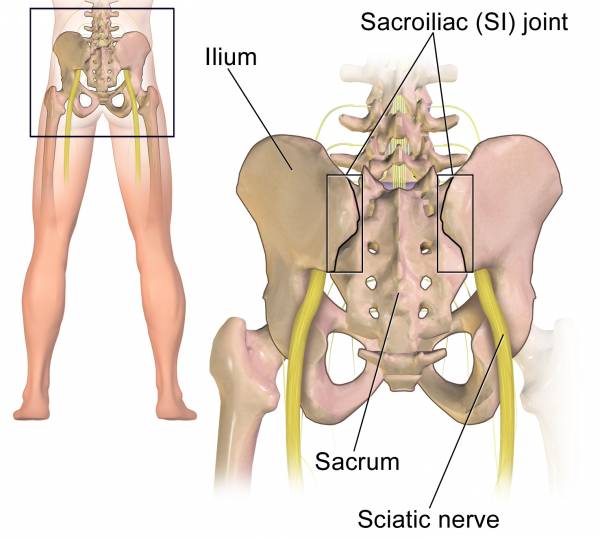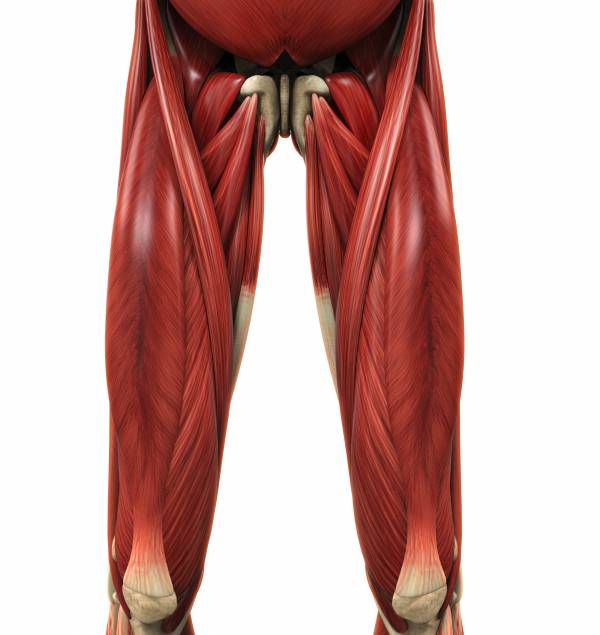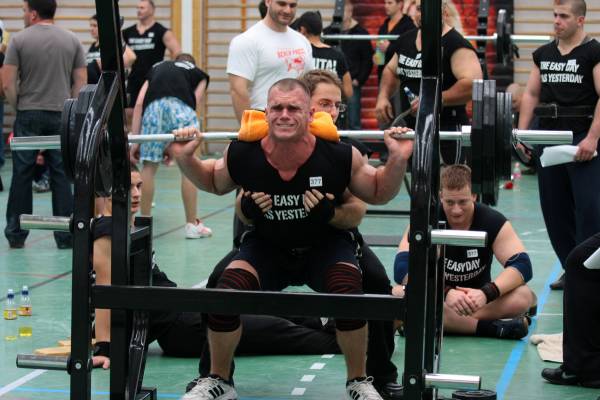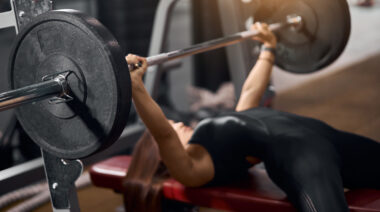The sacroiliac joint can get really beaten up in some people, leading to pain and injury. We call this joint the SIJ for short, and it’s basically where your sacrum and pelvis come together.
The sacroiliac joint can get really beaten up in some people, leading to pain and injury. We call this joint the SIJ for short, and it’s basically where your sacrum and pelvis come together.
The sacroiliac joint can get really beaten up in some people, leading to pain and injury. We call this joint the SIJ for short, and it’s basically where your sacrum and pelvis come together.

Anyone who has suffered from SIJ pain knows that it can be a real pain – in the back, in the hip, and even down the leg.
It can make day-to-day activities such as rolling over or getting in and out of a car difficult, and it can lead to pain while training if you’re not in tune with how to exercise properly without further injuring your SIJ.
So what is it with this joint that causes it to be so problematic for some people?
Anatomy of the SIJ
To understand, first you need to know a little bit of anatomy. For a long time it was thought that the SIJ was immobile, and looking at its anatomy it is easy to see why.
It is a very inherently stable joint. However, it is now known that mobility and movement of the SIJ is not only possible, but also essential for shock absorption during weight-bearing activities and to relieve some of the strain on the lumbar spine. What this motion looks like varies between individuals, but the quantity of motion is always small.
“In addition to strong ligaments, there are a number of incredibly strong muscles that surround the SIJ, including the erector spinae, psoas, quadratus lumborum, piriformis, abdominal obliques, gluteal muscles, and hamstrings.”
I won’t get into all of the complex anatomy of the SIJ, but know that its anatomical configuration, along with extremely strong ligaments, make the joint very stable.
And that these features seem to be more pronounced in men as compared to women. Meaning, women often have less stable joints than their male counterparts (though this is not always the case).
In addition to strong ligaments, there are a number of incredibly strong muscles that surround the SIJ, including the erector spinae, psoas, quadratus lumborum, piriformis, abdominal obliques, gluteal muscles, and hamstrings.
Though these strong muscles surround the joint, none of them actually act directly on it to produce active movements. Instead, movements are produced indirectly by gravity and by these muscles acting on the trunk and lower limbs.

A number of incredibly strong muscles surround the SIJ, including the erector spinae, psoas, quadratus lumborum, piriformis, abdominal obliques, gluteal muscles, and hamstrings.
The Purpose of the SIJ
Given its structure, the SIJ is designed to relieve stress and forces.
It acts as a buffer between the hip and lumbar spine. It transmits forces from the spine sideways into the pelvis and then into the lower limbs (and vice versa). This is accomplished through that minor but essential movement we were talking about before.
“Given its structure, the SIJ is designed to relieve stress and forces. It acts as a buffer between the hip and lumbar spine.”
The two major ways the SIJ does this are called nutation and counter-nutation. Nutation simply refers to when your sacrum (the bottom of your spine) rotates forward against the other two bones of your pelvis. Counter-nutation is the opposite. The sacrum posteriorly rotates against the other bones.
These movements – coupled with even smaller movements (such as gliding, and tilting, things you don’t really need to understand) – are what allow shock absorption to occur.
How Important Is the SIJ, Really?
A fantastic study completed by Dr. Stuart McGill looked at the forces transmitted to the SIJ during a 27kg squat.
He found the total force transmitted to this SIJ during this activity was 6.5 kN – which is enough to lift a small car off of the ground!
What this actually translated to was 1,461 pounds of force going through the SIJ. And that was with a smaller lift of only 27kg.
Now imagine what’s happening in our powerlifter friends who are lifting significantly more load than that.
So, what goes wrong and how do we fix it? SIJ dysfunctions fall in to two categories:
- Hypermobility or instability
- Hypomobility or stiffness
Simply put, if the joint moves too much, it is hypermobile, and if it moves too little, it is hypomobile.
Research published in Clinical Biomechanics in 1989 determined that muscle balancing is key, and that in order to have optimal SIJ stability (and movement) you need to focus on what they called the powerful two – the gluteus maximus and biceps femoris – as they exert shear and torsion loads proportional to the strength of their contraction.
“A fantastic study completed by Dr. Stuart McGill looked at the forces transmitted to the SIJ during a 27kg squat. He found the total force transmitted to this SIJ during this activity was 6.5 kN – which is enough to lift a small car off of the ground!”
These researchers also determined that weakness in the posterior chain (glutes and hamstrings) and tight psoas muscles can lead to aberrant SIJ motion and loading.
And, as with anything in the body, it isn’t always as simple as that, as the lats and connecting thoracolumbar fascia can also play a role in indirect stability to the SIJ

This means that in order to correct a hypermobile SIJ, we need to focus on the surrounding muscles, especially those in the posterior chain, and correct any imbalances.
Most commonly this means improving the strength of the gluteals, hamstrings and lats, but individual cases may vary.
Fixing a hypomobile SIJ can be a bit trickier, but believe it or not fixing muscle imbalances is exactly what we want to do in this situation, as well.
We need everything to be working optimally around the joint to solve this problem.
In Summary
- The SIJ is meant to be an extremely stable joint, one that has little movement.
- Though it is stable, it is crucial some movement does occur in order to absorb large forces headed for our lumbar vertebrae.
- Muscles imbalances absolutely affect the SIJ, even though none of these muscles directly act on the joint.
- Issues usually arise when the joint is either too mobile or not mobile enough.
If you have SIJ pain, or you think you have SIJ pain, the best thing is to see a trained professional who can diagnose you, let you know exactly where your pain is coming from, and help you develop a plan to fix it.
But regardless of whether you have a hypermobile or hypomobile SIJ, there are techniques and exercises you can do to alleviate and ultimately eliminate your pain and restore proper functioning of your SIJ.
“To keep your SIJ functioning properly and pain free, you need to work on optimizing your posture, core stability, hip mobility and stability, along with strength and motor control.”
Until then, if you’re beating up your SIJ without doing the work to keep it healthy, you’re going to regret it.
Remember what Dr. McGill found? That is a lot of force to be messing with, and if your SIJ is not working properly that force has to go somewhere – which is going to mean pain and injury for you.
Recommended Exercises
To keep your SIJ functioning properly and pain free, you need to work on optimizing your posture, core stability, hip mobility and stability, along with strength and motor control.
Even more, working on reciprocal movement patterns that challenge the core as well as work the contralateral lats and glutes is key here.
My recommendations are simple, but effective:
- Bear walk
- Glute bridge variations
- Plank variations
- Dead bugs
Watch the videos below for more instruction. Try working these into your regular routine and see if it doesn’t make a difference in how you feel.
Further Reading:
- Essential Tips to Improve Natural Hip Function
- Everything You Need to Know About the Iliopsoas
- Rehabilitation for Lumbar Spine Recovery: The Science and the Truth
References:
1. FJ Vera-Garcia, JL Elvira, SH Brown, SM McGill. “Effects of abdominal stabilization manoeuvres on the control of spine motion and stability against sudden trunk perturbations.” Journal of Electromyography and Kinesiology 17 (2007) 556-567.
2. SL Forst, et al. “The Sacroiliac Joint: Anatomy, physiology and clinical significance.” Pain Physician 9 (2006) 61-68.
3. D Lee. Pelvic Stability and Your Core. American Back Society Meeting, San Francisco 2005.
4. S. McGill. “Recent advances in lumbar mechanics with relevance to clinicians.” The Journal of CCA (1989) 82-92.
5. Vleeming A, Van Wingerden JP, Snijders CJ, Stoeckart R, Stijnen T. “Load application to the sacrotuberous ligament. Influences on sacroiliac joint mechanics.” Clin Biomech 1989; 4:204-209. 49.
6. Vleeming A, Stoeckart TR, Snijders CJ. “The sacrotuberous ligament: A conceptual approach to its dynamic role in stabilizing the sacroiliac joint.” Clin Biomech 1989; 4: 201-203.
Photos courtesy of Shutterstock.






